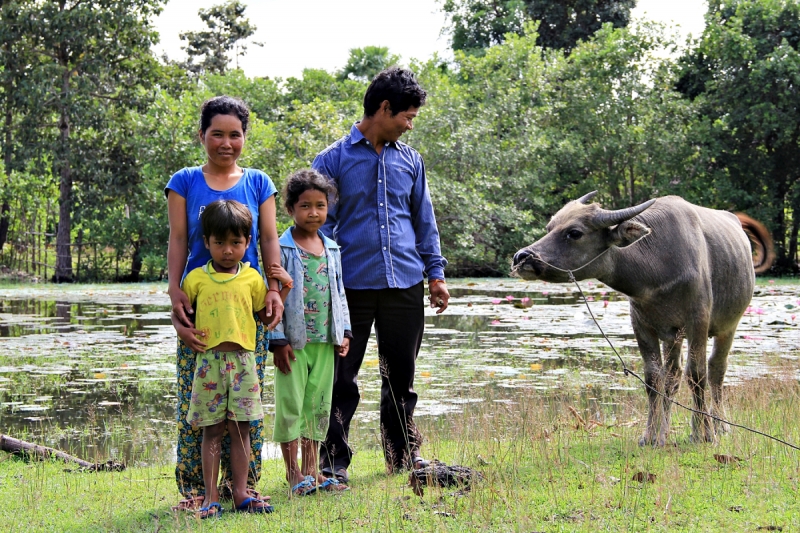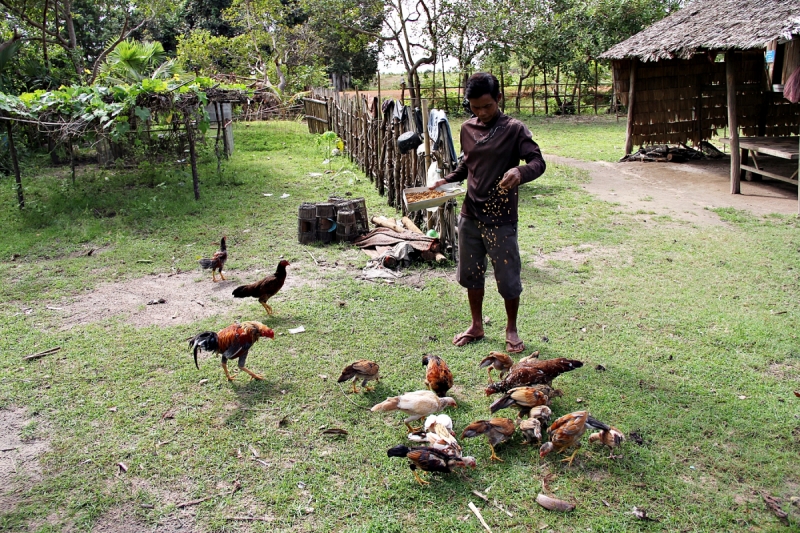




When one talks about agriculture, what instantly comes to mind for most people are crops – rice, wheat, corn, among others, cultivated in healthy soil and grown in a sufficient amount of sunlight.
There is nothing wrong with this definition, as it is partly correct. However, crop production is only a part and parcel of the broader area that the term encompasses. Strangely, most people would often forget an equally important aspect of agriculture – livestock.
Just like how agriculture is conceived, much of the spotlight in the agricultural development arena is given to crop production. In this database alone, there are a total of 355 projects listed under Crop Production, compared to the meager 134 in the Animal Production sector. This small sample only represents a larger truth: that there is relatively less attention given to livestock in agricultural development.
But why is there a need to equally focus on livestock?
Well, for one, livestock produces a wide variety of nutritious by-products – such as milk, cheese, eggs and meat – which not only translates to additional income, but a healthy meal on a family’s table. The animals can likewise serve as natural weed controllers and an essential source of traction power for crop farmers, helping increase the amount of land that can be cultivated. Their manure, on the other hand, makes for great fertilizers. In their own small but efficient ways, livestock can contribute largely to a family’s health and living.
Added to this is the fact that rural families, with little or no access to financial services, can utilize livestock as some form of asset, which they can invest in when they have extra money, and sell when they are in need. Ultimately, this can help poor families become more resilient in the face of shocks in disasters, thus aiding them to finally conquer poverty.
This could have long been the case in Cambodia – a beautiful, largely-agricultural country in the Lower Mekong Region – had they not faced constraints in growing livestock back then.
Cambodia and the Dilemma of Livestock
Mr. Julien Brewster, Livelihoods and Environment Program Manager of People In Need (PIN), explained some of the problems faced by livestock farmers in Cambodia.
“[We] started noticing the significant impacts that the high rates of livestock mortality and the lack of veterinary services were having on smallholder farmers across the country. For example, a survey of 641 smallholder farmers in 2013 found that 62 % of raised chicks, 27 % of adult chickens and 11 % of pigs died from preventable diseases, causing costly financial losses to farmers and the Cambodian economy. The same survey found that 80% of poultry, 43% of pigs and 14% of cattle are never vaccinated and a large number of livestock farmers don’t use qualified veterinary services.”
But it did not take long before Mr. Brewster and his team realized the solution. “Through this and further research we realized that improving the quality, accessibility and farmers’ demand for private veterinary services can play a crucial role in reducing poverty in Cambodia.”
It is in this actualization that the Community Livestock Market Development (CLIMAD) was born.
CLIMAD and Livestock Market Development in Cambodia
Implemented by PIN with financial support from the European Union and the Czech Development Agency, CLIMAD is a rural development initiative that engages the private sector, civil society organizations and relevant authorities in reducing the poverty of 30,000 livestock smallholders living in 205 villages of Pursat and Kampong Chhnang provinces in Cambodia.
To achieve this, CLIMAD’s team is working to enable local veterinarians, veterinary companies and local shops to improve the quality, accessibility and demand for private, community-based veterinary and marketing services. As a result, farmers are able to boost their incomes from livestock production while service providers increase their profits, generating win-win solutions for addressing livestock smallholders’ needs.
At the same time, CLIMAD ensures that the promoted livestock raising practices are environmentally sensitive and beneficial to key animal care-takers – women and youth.
With a duration of 3.5 years, a total budget of 1.4 million USD and a team of 35 staff, CLIMAD is one of the largest livestock market development projects in the region.
Related: Waking Up to a Better Life: CLIMAD and the Case of Long Sinang
Building Capacities, Improving Lives
From its commencement in 2013, CLIMAD had substantially achieved what it was made to do. Mr. Brewster details the activities they have conducted, which made the overall program a success.
“Activities include support for the members of grassroots groups to benefit from cooperation in smaller, informal and easily manageable Livestock Farmers’ Networks (of friends, neighbors, etc.), especially by:
a) making required inputs more affordable (e.g. by sharing the costs of purchased vaccination medicine);
b) attracting the services of the private and state services providers and reducing their costs; and
c) improving their income through collective sale and marketing of products.”
Aside from encouraging unity among farmers for their own benefit, CLIMAD also provided capacity-building initiatives for their beneficiaries.
“Village Animal Health Workers’ (VAHWs)-driven promotion campaign and provision of trainings, coaching and exposure visits are also supported to help strengthen farmers’ technical know-how and demand for services. Local partners, NGOs, and PIN achieve this through helping veterinary companies and provincial livestock government agencies provide training to address the gaps in local veterinary shops’ and VAHWs’ technical, promotion and advisory skills.”
According to Mr. Brewster, the project also supports local governance mechanisms by building farmers’ understanding of their rights and authorities’ role (through farmer forums at the commune and district level), so that farmers can influence and hold these authorities accountable for the decisions they make.
These, among many others, are the fruits of what Mr. Brewster’s team has planted two years ago.
Not an Easy Feat

But just like any other projects, CLIMAD has its own share of bumps along the road. One of the issues that the project faced is migration, as explained by Mr. Brewster.
“Migration, especially of youth, from rural areas for job opportunities in the cities or neighboring countries is having an impact on the agriculture sector by decreasing the availability (and increasing the cost) of labor. This has affected the project to some extent as farmers involved with the project have migrated out of the target areas.”
The level of commitment that the beneficiaries have has likewise posed a threat to the project’s progress.
“The motivation of selected VAHWs and farmers can also be a challenge, and have required us to strengthen our selection process to ensure that beneficiary selection is only targeted to those who really want the support and will make the best use of it.”
Furthermore, the policy environment of the livestock sector (such as the lack of control and regulation on livestock and veterinary product imports) has a significant impact on smallholder farmers’ engagement in the sector. However, as Mr. Brewster mentioned, many of these policy level issues are outside of the project’s influence.
Moreover, CLIMAD’s team likewise faces difficulties in convincing farmers of the importance of vaccinating their chickens. As explained by Mr. Brewster, there is a lack of trust towards vaccinations (which may partly be due to the lack of regulations and standards on imported vaccinations), and farmers do not value their chickens the same way that they value other livestock. Changes to these behaviors and practices, unfortunately, will take time.
Standing Unfazed
Even though some problems are beyond the project’s control, Mr. Brewster’s team is not ready to give up just yet.
“Regarding policy-level changes needed to the livestock sector, we work with the government to ensure that our inputs and lessons learned from the project are channeled to decision-makers… and also support sub-national and commune level forums where farmers can share their livestock and livelihood-related priorities with local authorities and government agencies.”
As for the issue on migration, CLIMAD offers a unique solution.
“We do not try to prevent migration, but rather ensure that farmers, especially the youth, are given opportunities to develop their livestock production skills and their income earning potential from this sector, to ensure that they have options and do not feel forced to leave their homes for work elsewhere,” said Mr. Brewster.
Breathing Life to Sustainability
But more than providing solutions to the challenges in the project’s implementation, CLIMAD’s team is now moving forward to a more important issue now that the project’s culmination in 2016 is nearing – how to make what was begun in 2013 a lifetime success.
Mr. Brewster expressed his sentiments about the importance of sustainability.
“Sustainability needs to be the guiding principle of any decision-making on project and activity design. There has been so many rural livelihood projects and interventions implemented in Cambodia that have stopped functioning after the project time frame has ended. In many cases this is because inputs (such as animal vaccinations) are handed out for free or heavily subsidized and any production support is not adequately linked to the market.”
This has brought detrimental effects to the farmers. “Along with wasting project resources this has also contributed to a dependency mindset amongst rural farmers, which can be disempowering and damaging to the long-term development of the agriculture sector,” said Mr. Brewster.
According to Mr. Brewster, sustainable project impacts can better be ensured through creating ownership in project participants by:
a) relying on the motivation of farmers to improve their production (emphasizing on the importance of beneficiary selection);
b) support for farmer-to-farmer extension approaches focused on easily transferable skills and demonstrations; and
c) promotion of appropriate technologies, networking and other information dissemination.
“Farmers should also be supported to cooperate in groups as a way to share their technical know-how and also to cooperate on marketing efforts such as selling their products collectively, which can allow them to negotiate and receive higher prices,” he added.
In the changing development landscape, it is not only Mr. Brewster’s team who’s concerning themselves with sustainability. In fact, sustainability is the new global buzzword in the development arena. With the Sustainable Development Goals (SDGs) on its way, many countries are given yet a bigger challenge of improving people’s lives, and Cambodia is no exception.
But Cambodia’s livestock sector need not be afraid. With CLIMAD and other organizations’ relentless efforts in channeling development initiatives toward livestock, there is great hope that the dynamic noise of chickens, pigs, goats, and other farm animals would continue to echo across the country.
Because this is how true sustainable development sounds – alive.